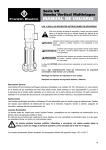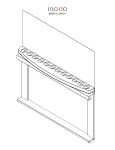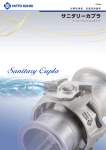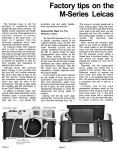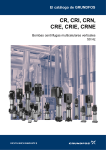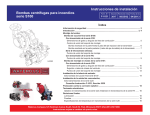Download 106624101 VR Series Owners Manual 01.10.indd
Transcript
VR SeriesVertical Multistage Pump OWNER'S MANUAL V- Connections with rapid fittings type “VICTAULIC”: the pump is supplied with the collars(Optional accessories). C- Connections with round fittings type CLAMP FlexiClamp: the pump is supplied without collars (Optional accessories). 1.3 Applications VR centrifugal multi-stage pumps are suitable for a wide range of applications. They can be used in agriculture as well as in the civil and industrial field, as for example: water tank, watering, irrigation, high pressure washing, fire fighting protection, air conditioning, etc. Before any procedure of installation, handling or start of the pump, read the instructions contained in this manual carefully. Follow step by step the rules for the correct assembly of the components and observe the provisions of the country of use concerning the best practice of the state of the art. 1. GENERAL DATA 1.1 General description VR pumps are vertical multistage centrifugal pumps. Models 3VR, 5VR and 9VR operate with clockwise rotation when observed from above. Models 16VR operate counter-clockwise when observed from above. (Exceptions can exist in high pressure assemblies where one of the two pumps has operation and hydraulics inverted.) These pumps are not self-priming. Pump intake and discharge are located on the same axis, at the bottom of the pump. A standard mechanical seal in the shaft inlet provides separation of the electric motor from the pumped product. Mounting dimensions can be found on the dimensions table, page 5. 1.2 Flanges available: F- Round flanges on body type PN25: the pump is supplied with joints, bolts and counterflanges. T- Oval flanges on body type PN16: the pump is supplied with oval counterflanges for pipe to be screwed, joints and bolts (Optional accessories). 1.4 Pumped liquids Clean liquids, compatible with the construction materials of the pump, not containing solid particles or fibres. If the pump is used to pump liquids with viscosity or a density higher than water ones, it is necessary to use a motor with a proportionally greater power. 1.5 Temperature of pumped liquids The pumped liquids must remain within a given temperature range: -20 ºC to +120 ºC 2 DELIVERY AND STORAGE 2.1 Delivery The pumps are supplied in their original package in which they must remain until they are installed. Pay attention not to subject the pump to flexing after unpackaged: this may cause the misalignment or the damaging of the pump itself. Take care not to bump or bind the components. 2.2 Storage and Handling Storage temperature: Pump: -20 ºC to +60 ºC Neither the pump, nor the motor should be exposed to sunlight. If the pump was not packaged, it has to be stored in the warehouse vertically, in order to prevent any possible misalignment. The pump must be protected against frost and atmospheric agents. During storage, the pump can be supported as shown in figure 2.1. In case of lack of the motor use a belt wrapped on the pump head, paying utmost care not to damage the lateral joint covering protections. The motors of the pumps supplied with eyebolts must not be used to handle the whole assembled electropump (see fig. 2.2). 3 INSTALLATION AND PREPARATION There can be two relevant application cases: 3.1 Ambient temperature Maximum: +40 ºC. Should the temperature of the pumped liquid exceed 40 ºC, or in case of use at high altitude (higher than 1000 meters), the motor power reduces due to the reduced density of air useful to cool the same. In some cases, it may be necessary to replace the motor with one with greater power. Here below there is an aproximate diagram concerning the yield of the motors according to altitude or temperature. P/Pn % 110 100 90 80 70 60 500 1000 1500 2000 2500 3000 3500 Haltitude m max 40 45 50 55 60 Tambient °C max 3.2 Minimum suction pressure Check the characteristic curves of the pumps to assess the NPSH factor and avoid cavitation problems (fig. 1 case B). 3.3 Maximum pressure during suction It is important to keep the sum of the inlet and of the outlet pressure, this latter against closed valve, always lower than the maximum operation pressure allowed by the pump (fig. 1 case A). 3.4 Minimum rate flow The operation of the pump at a lower level than the minimum rate flow allowed can cause excessive overheating and damage the pump. The pump must never operate against a closed delivery valve. 3.5 Power supply data See motor nameplate. 4 INSTALLATION Legend figure 1: 1- Filter 2- Bottom valve 3- Gate valve 4- Pressure gauge 5- Check valve 6- Floating device 7- Anchorings for pipings 2 - Case shown in fig. 1.A: Pump under pressure, which both from a tank as shown in figure and from civil waterworks system, shall allow the plant to foresee a protection against water lack (see fig. 1.6). - Case shown in fig. 1.B: Pump in suction. 4.1 Assembly Install the pump in an accessible place, protected against frost and as close as possible to the water suction point. The pump must be tightly fastened to the basement by means of bolts, for the measures of the holes and their distance between centres, see the table on page 5. To minimize the noise generated during the operation, it is suggested to assemble the anti-vibration joints on the tie rods fastening the base to the flooring. Before proceeding to the final tightening of the pump, make sure that it is in vertical position, otherwise adjust the position with proper shims. On the base of the pump it is indicated, by means of arrows, the inlet and output direction of the pumped fluid. On the lantern there are the arrows indicating the motor rotation direction. The pump can be assembled vertically or horizontally, in any case it must not be placed vertically with motor located in the lower part. To avoid unnecessary stresses on the pump body, place some support brackets (see fig. 1.7) in order to support the incoming and outcoming pipe. To avoid air blows affecting the pump operation, foresee an inclination of the incoming pipes not lower than 2%. Protect the pump against possible water hammers by means of a check valve (bottom valve). Install a shut-off valve upstream and downstream of the pump in order to allow its insulation in case of maintenance and disassembly. 4.2 Electric connections The electric connection must be carried out by qualified technicians in compliance with the regulation in force in the countries of installation of the pump. Before replacing the cover of the terminal board and removing / disassembling the pump, make sure power supply has been disconnected. The data concerning motor power supply are given on the rating plate of the same. Before starting the motor, check that electric power supply complies with the features of the same. For the connections, use electric cables complying with local regulations. When observed from above, standard 3VR, 5VR and 9VR pumps should rotate clockwise, 16VR should rotate counter-clockwise. If necessary, the motor can be rotated on its axis to ease the access to the same by maintenance technicians. In this case, it is necessary to unscrew the screws tightening the motor on the pump, remove the joint covering safety carter and rotate the motor on its seat paying attention not to remove the coupling joint. Reassemble the joint covering carter and re-tighten the screws of the motor at the end of the above mentioned procedure. Wire electric cables to the motor according to the diagram given within the cover of the terminal board. Avoid any contact of the electric cables with the pipes or other parts of the pump. Carefully insulate the cables against humidity. ALWAYS CONNECT THE GROUND. 5 COMMISSIONING CAUTION: The pump must NOT be started without previous filling. Dry running can damage irreparably the mechanical seal and the bearings. Make sure not to remain in the trajectory of liquid output from the valve during the start of the pump, a liquid output may occur during the drainage, which would be dangerous for the user in case the liquid is at high temperature or in case of pumping of hazardous liquids. 5.1 Filling and drainage 5.1.1 Pump under pressure (see figure 1.A and figures 3.A and B) 1- Close the gate valves on the delivery side of the pump in order to avoid the flow in the circuit of the fluid that is being used to fill the pump. 2- Remove the upper drainage cap (see fig. 3.A) and unscrew slightly the by-pass valve (see fig. 3.B) in order to let the two internal chambers of the pump communicate and ease their filling. Do not remove completely the by-pass valve, this is removed only and exclusively to empty the pump. In the filling phase just unscrew it for 3 or 4 turns. 3- Open the gate valve located on the pump suction side in order to let the fluid come out on the pump. Make sure that the difference in level between the pump and the shutter is such as to assure a complete filling of the pump. 4- When there is an homogeneous flow from the drainage cap close it again carefully. Close the by-pass valve. 5- Check the motor rotation direction as indicated on the same. 6- Start the pump and check that it rotates on the right direction. 7- Open the gate valve slowly on the discharge side until stroke end. Pay particular attention to point 3 in case the pump is filled with hot or hazardous liquids, since the fluid coming out of the upper drainage cap may hit people. Make sure you are in a safety position during this operation. Close the gate valve after the outcome of a constant liquid flow from the cap before closing it again in order to avoid the contact with the liquid. 5.1.2 Pump in suction (see figure 1.B and figure 3.A, B and C) 1- Close the gate valve on the pump delivery side in order to prevent the flow in the circuit of the fluid that is being used to fill the pump and open the gate valve on the suction side. 2- Remove the upper drainage cap (see fig. 3.A) and unscrew slightly the by-pass valve (see fig. 3.B) in order to let the two internal chambers of the pump communicate and ease their filling. Do not remove completely the by-pass valve, this is removed only and exclusively to empty the pump. In the filling phase just unscrew it for 3 or 4 turns. 3- Fill the pump as shown in figure 3.C until the fluid comes out from the upper drainage cap. 4- Carefully close the cap again. 5- Check the motor rotation direction as indicated on the same. 6- Start the pump and check that it rotates on the right direction. 7- Open the gate valve slowly on the discharge side until stroke end. CAUTION: the pump must not work for more than 10 minutes with the delivery valve closed and with pumped liquid temperature higher than 40ºC. If the temperature is higher, limit this time to 5 minutes. 6 MAINTENANCE Before any intervention on the pump, make sure that power supply has been disconnected and that it cannot be restored accidentally during maintenance. The bearings of the pump and the mechanical seal do not require maintenance. If the pump is emptied before a long period of standstill, remove one of the joint covering elements and grease slightly with silicone oil the shaft between the head of the pump and the motor in order to avoid the gluing of the mechanical seal. Motors without greasing nipple: the bearings are lifelong greased and do not require any greasing. Motors with greasing nipple: grease these motors with lithium oil for high temperatures following the instructions given on the motor cover. In case the pump works seasonally, grease the motor before any prolonged standstill. To protect the pump against frost, empty it completely removing the upper drainage cap (see fig. 3.A) and extracting the by-pass valve (see fig. 3.B) completely in order to let all the liquid flow outside the pump. Once the pump has been emptied, let it without caps. When proceeding to its commissioning again, repeat the filling and drainage according to point 5. 3 7 TROUBLESHOOTING TABLE Before any intervention, disconnect the pump from power supply. If the pump is used for hazardous liquids for human beings, inform compulsorily the personnel performing the repairing. In this case, clean the pump, in order to assure the safety of the operator. See table below. Fault Cause Remedy 7.1 The motor does not run when started. a) Lack of power supply. Connect power supply. b) Blown out fuses. Replace fuses. c) Thermal protection tripped. Restore the thermal protection. d) Motor defective. Replace the motor. 7.2 The thermal protection of the motor starter trips at start. 7.3 The thermal protection of the motor starter trips now and then. 7.4 The flow rate is not constant. 7.5 The pump rotates but does not supply water. 7.6 The pump vibrates. a) Fault in the contacts of the thermal Replace the contacts of the motor switch of the motor starter. starter. b) Connection of the cables faulty. Tighten or replace the cables. c) Motor wiring faulty. Replace the motor. d) Mechanical block of the pump. Remove the mechanical pump block. e) Calibration of the thermal relay Calibrate the motor starter correctly. too low. a) Calibration of the thermal relay Calibrate the motor starter correctly. too low. b) Low voltage during the peaks. Check power supply. a) Pressure too low during suction (cavitation). b) Suction manifold / pump partially obstructed by impurities. c) The pump sucks air. Clean the pump or the suction manifold. Check the suction conditions. a) Suction manifold / pump partially obstructed by impurities. b) Bottom valve or check valve blocked in closed position. c) Leak in the suction manifold. Clean the pump or the suction manifold. Repair the bottom valve or the check valve. Repair the suction manifold. d) Presence of air in the suction Check the suction conditions. manifold or in the pump. e) The motor rotates in wrong Change the motor rotation direction. direction. a) Anchoring on the plinth faulty. Verify and completely screw the nuts of the bolts of the studs. b) Foreign body obstruct the pump. Disassemble the pump and clean it. c) “Hard” rotation of the pump. d) Electric connection faulty. 4 Check the NPSH of the pump. Verify that the pump rotates freely without anomalous hindrances. Verify the connections of the pump. 5 75 75 80 90 250 250 280 300 3VR 5VR 9VR 16VR L H (mm) H L (mm) Pump Type 50 40 32 25 DN 130 130 100 100 L1 (mm) DN 200 200 150 150 L2 (mm) L1 L2 215 215 180 180 B1 (mm) 250 250 210 210 B2 (mm) B1 B2 13 13 13 13 øD (mm) 4xØD 200 200 160 160 L (mm) L 90 80 50 50 H (mm) 2 1-1/2 1-1/4 1-1/4 D (Rp) D T-Version (Oval) H F-Version (Round) H 261 261 210 210 L (mm) 60,3 60,3 42,2 42,2 D (mm) 202 202 162 162 L (mm) H 90 80 50 50 L (mm) L 87 87 59 59 D1 (mm) C-Version Flexi-Clamp D2 40 40 36 36 D2 (mm) Director of Engineering - R&D Riccardo Fornasa DECLARATION OF CONFORMITY The above listed products comply with the following Directives: Machinery Directive 98/37/EC. Low Voltage Directive 2006/95/EC. Electromagnetic Compatibility 2004/108/EC. They are also subject to the following harmonized standards: EN 809, EN 60335-2-41 90 80 50 50 H (mm) L V-Version Vitaulic D DIMENSIONS D1 Fig. 1 3 5 6 3 A 4 8 6 10 100 4 150 12 50 200 2 0 0 14 230 16 3 1 3 2% B 2 1 6 7 7 3 Fig. 2 1 2 Fig. 3 B A C 7 LIMITED WARRANTY Franklin Electric Co., Inc. Franklin Electric Co., Inc. warrants its new products to be free of defects in material and workmanship for a period of 1 year from date of installation or 2 years from date of manufacture, whichever comes first, WHEN installed in clean, potable water applications. Warranty does not cover applications pumping saltwater or other corrosive liquids. Consult and adhere to local codes for all applications. Franklin Electric Co., Inc. also provides additional warranty coverage on specific products as specified herein. Franklin Electric’s warranty obligation with regard to equipment not of its own manufacture is limited to the warranty actually extended to Franklin Electric by its suppliers. This warranty extends only to the original retail purchaser and only during the time in which the original retail purchaser occupies the site where the product was originally installed. Requests for service under this warranty shall be made by contacting the installing Franklin Electric dealer (point of purchase) as soon as possible after the discovery of any alleged defect. Franklin Electric will subsequently take corrective action as promptly as reasonably possible. Franklin Electric at its discretion may replace or repair any product that fails under this warranty after inspection by an authorized company representative or after Franklin Electric has received the product at our factory. Replacement or repair cannot be made until after the product is inspected. All charges or expenses for freight to and from the factory, removal and reinstallation of the product, or installation of a replacement product are the responsibility of the purchaser. THIS WARRANTY SUPERSEDES ANY WARRANTY NOT DATED OR BEARING AN EARLIER DATE. ANY IMPLIED WARRANTIES WHICH THE PURCHASER MAY HAVE, INCLUDING MERCHANT ABILITY AND FITNESS FOR A PARTICULAR PURPOSE, SHALL NOT EXTEND BEYOND THE APPLICABLE WARRANTY PERIOD. IN NO EVENT SHALL FRANKLIN ELECTRIC BE LIABLE FOR INCIDENTAL OR CONSEQUENTIAL DAMAGES. This warranty does not apply to any product which has been subjected to negligence, alteration, accident, abuse, misuse, improper installation, vandalism, civil disturbances, or acts of God. The only warranties authorized by Franklin Electric are those set forth herein. Franklin Electric does not authorize other persons to extend any warranties with respect to its products, nor will Franklin Electric assume liability for any unauthorized warranties made in connection with the sale of its products. THIS WARRANTY GIVES YOU SPECIFIC LEGAL RIGHTS, AND YOU MAY ALSO HAVE OTHER RIGHTS WHICH MAY VARY FROM COUNTRY TO COUNTRY. ASEAN AUSTRALIA / NEW ZEALAND Franklin Electric (SEA) Pte Ltd. Singapore Representative Office 1 Changi Business Park Avenue 1 # 03-01, Ultro Building Singapore 486058 Franklin Electric (Australia) Pty. Ltd. 106 - 110 Micro Circuit Dandenong South, Victoria 3175 Australia Phone: +61.3.9799.5000 Phone: +65.6789.6865 Fax: +61.3.9799.5050 Fax: +65.6789.0155 www.franklin-electric.com.au CHINA LATIN AMERICA Franklin Electric (Shanghai) Co., Ltd. Room 1101, New HongQiao Center Bldg. No. 83 LouShanGuan Road, Shanghai 200336, China Motores Franklin S.A. de C.V. Avenida Churubusco #1600 (Bodega #16) Col. Francisco I. Madero Monterrey, N.L. Mexico C.P. 64560 Phone: +86.21.6236.8900 Fax: +86.21.6236.8903 Phone: +52.81.8000.1000 Fax: +52.818.864.8445 UNITED STATES Franklin Electric Co., Inc. 400 E. Spring St., Bluffton, IN 46714 USA Tel: +1.260.824.2900 Fax: +1.260.824.2909 106624101 Rev. 0 01.10 www.franklin-electric.com










